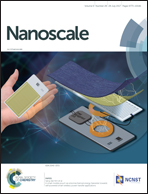Self-assembly of MoO3 needles in gas current for cubic formation pathway†
Abstract
Nucleation and subsequent rapid growth are enigmatic due to the unrevealed pathways. Despite the relatively simpler mechanism compared to nucleation and growth in solution, that in vapor has received little attention. The largest hindrance to unveiling this process may be observing the rapid and mesoscopic-scale phenomena. To overcome this hindrance, we combine an experimental approach with in situ spatial scanning Fourier-transform infrared spectroscopy, which reveals the nucleating and growing nanoparticles in vapor. The nanoparticles are then collected at different evolutionary stages and analyzed by ex situ transmission electron microscopy (TEM). Needle-shaped molybdenum oxide (MoO3) nanoparticles were formed within ∼0.1 s after homogeneous nucleation from a highly supersaturated vapor. Over one second, the needle particles gradually evolved into a cubic shape by fusion in a crystallographically favored orientation in a free-flying state in vapor. The similar sizes of the elongated axes of the needle and cubic structures suggest an additional growth stage, in which the needle particles become the growth units of the cubic particles. The morphology of a final crystal should reflect the formation environment of the particle because growing crystals are sensitive to the formation conditions such as temperature, concentration, and impurities. Although nucleation under very high supersaturation induces the anisotropic growth of the needle particles, this information of the initial nucleation environment is lost in the final cubic crystal. These findings enrich our understanding of pathways in the nucleation and growth of nanoparticles and provide new insights into the growth stages driven by oriented attachment.



 Please wait while we load your content...
Please wait while we load your content...